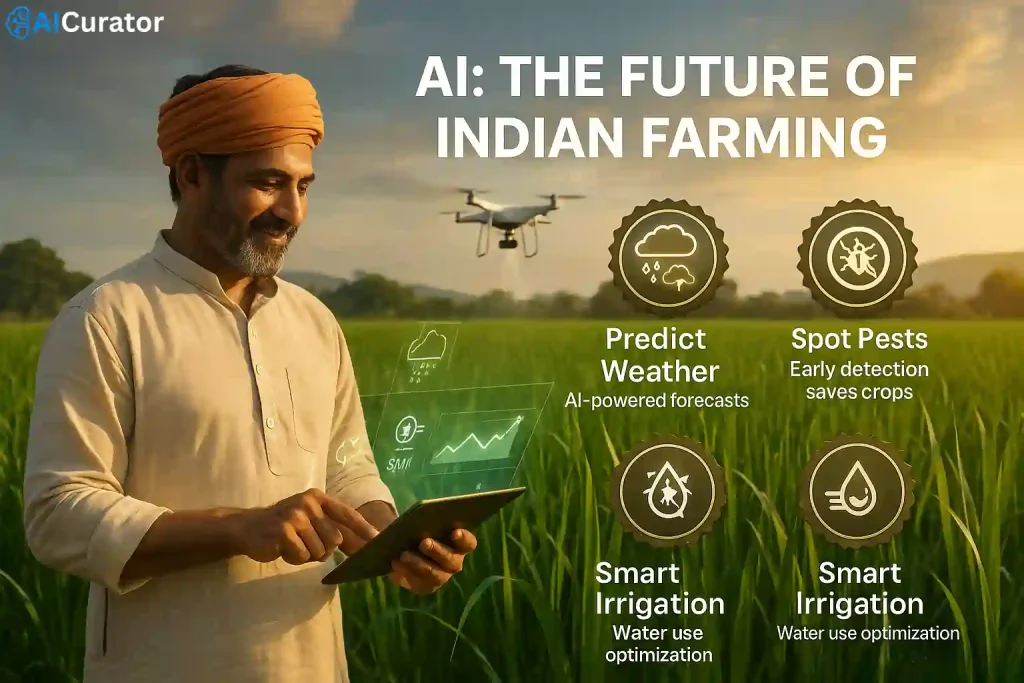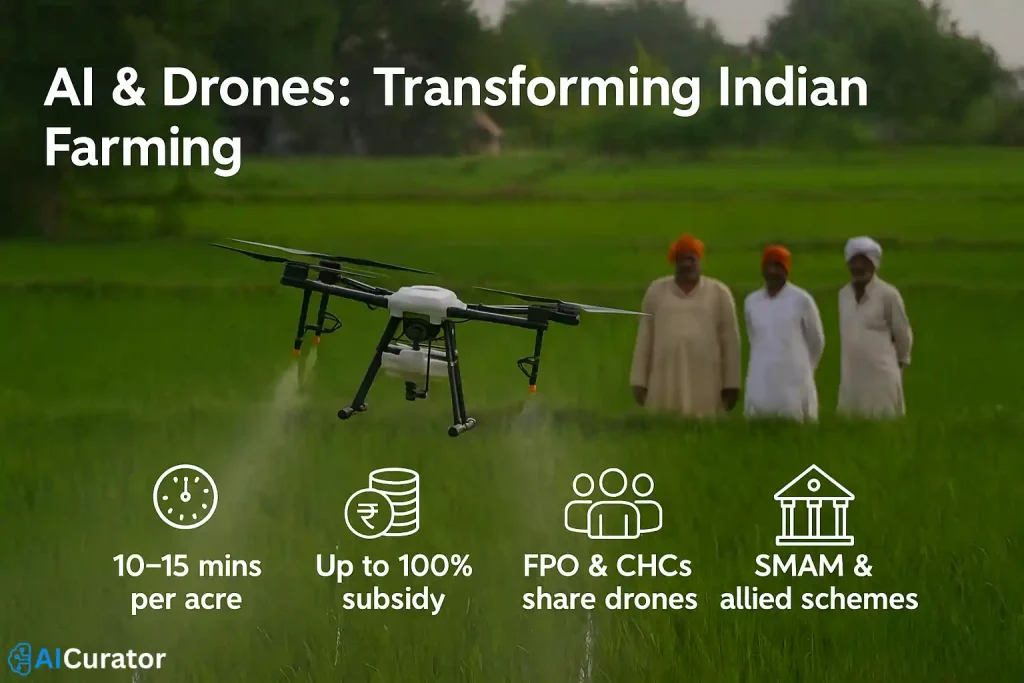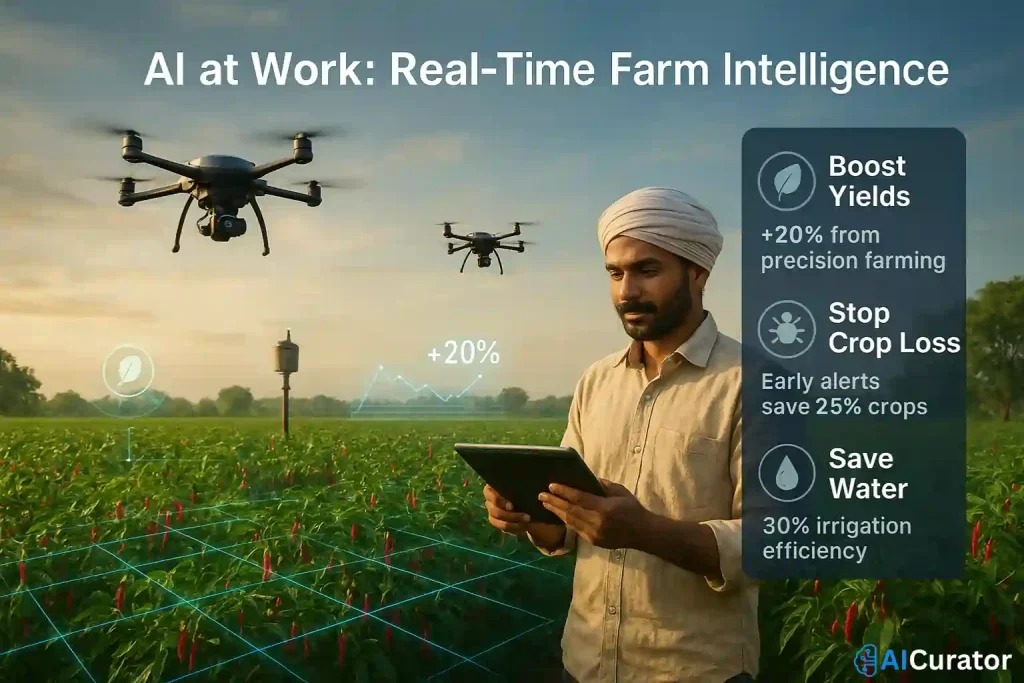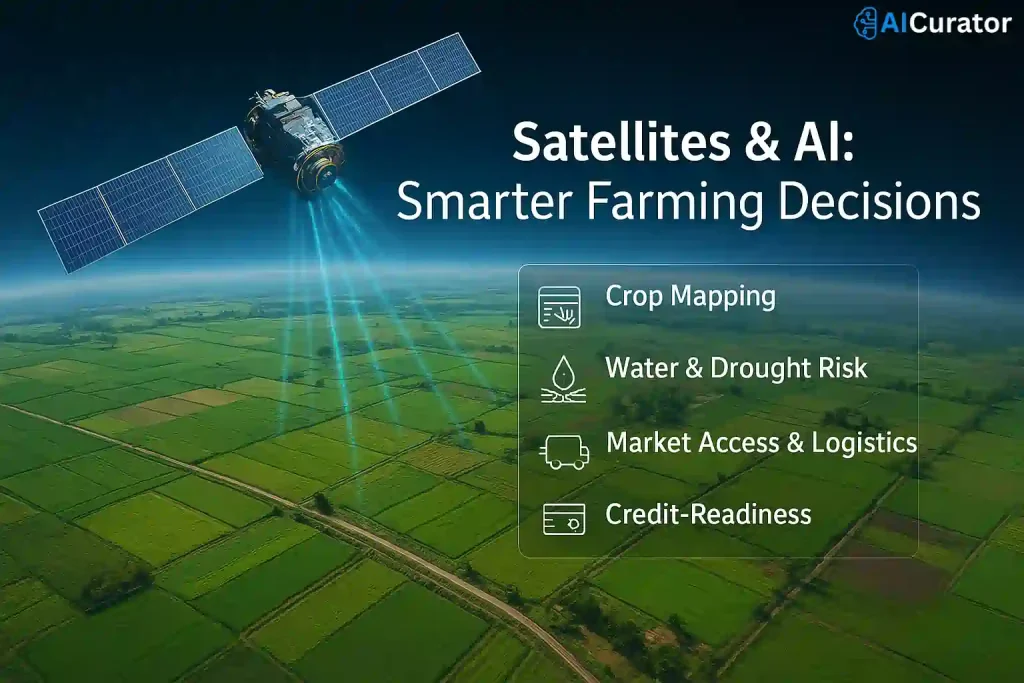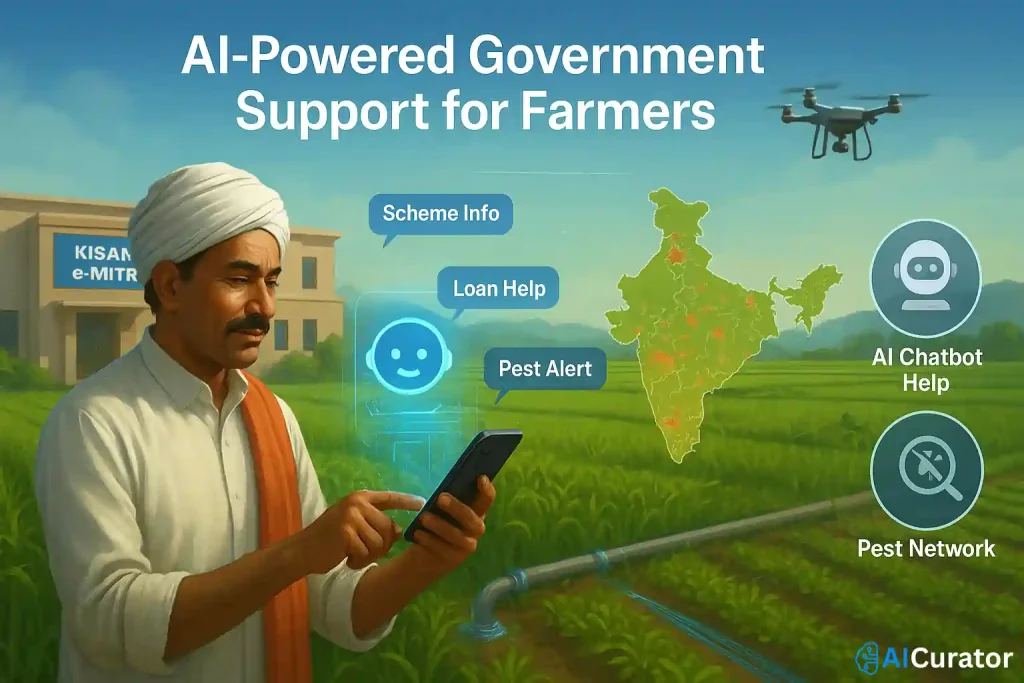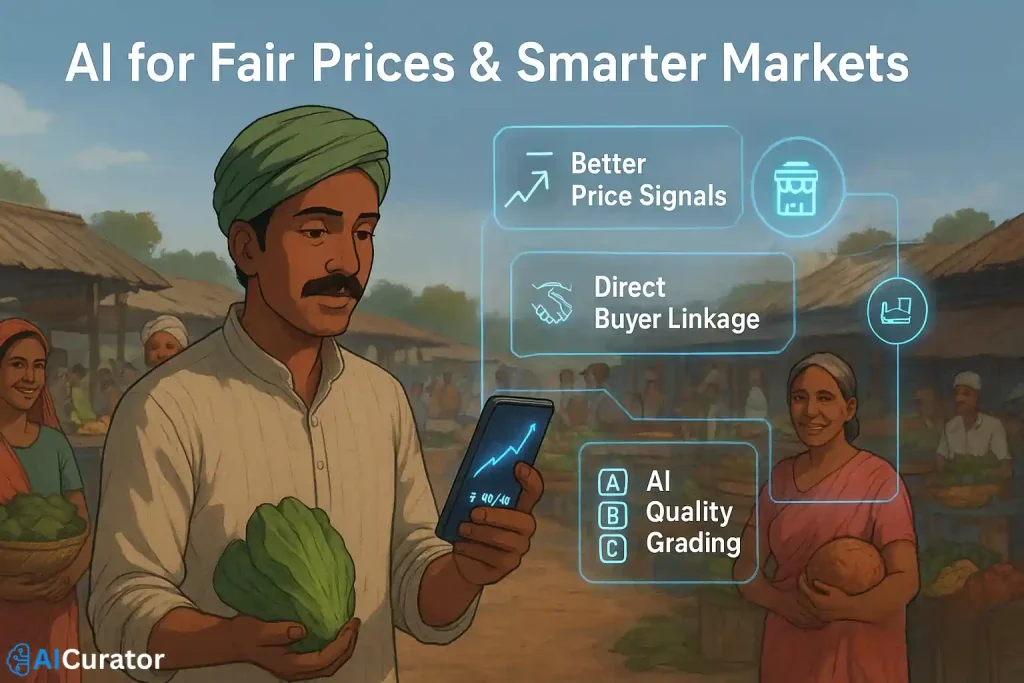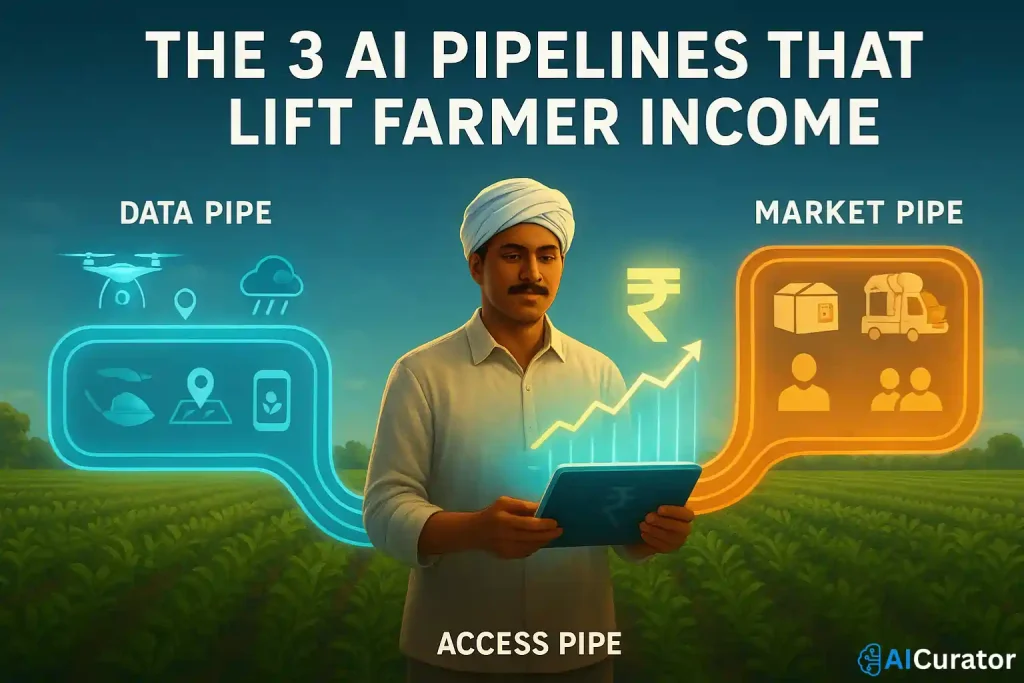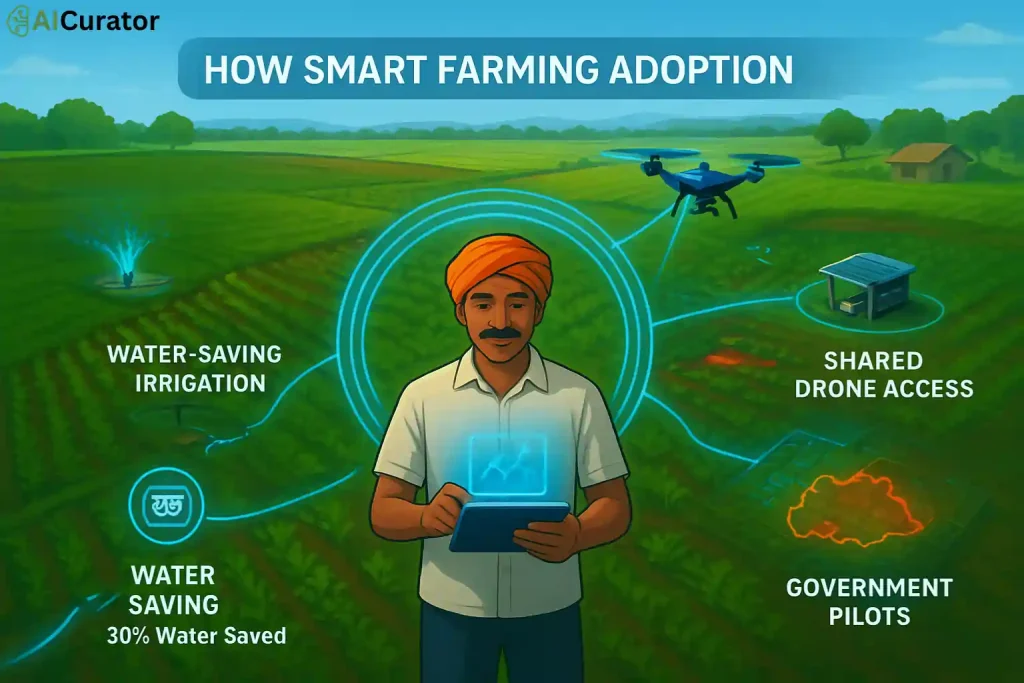Rural incomes face heat from erratic monsoons, rising input costs, fragmented landholdings, and price shocks—yet a new set of AI tools is starting to cut waste, boost yields, and plug farmers directly into markets.
From drone spraying and pest alerts to satellite-led crop maps and AI chatbots in local languages, the shift is already visible across states where Indian farmers are testing these solutions.
AI won’t fix everything overnight. But done right—open data, low-cost access, last-mile support—it can improve margins for smallholders and de-risk a tough season.
AI in Agriculture: Key Takeaways
- AI in Indian agriculture is scaling fast, with market size in India estimated at $70M in 2024 and projected to reach $350M by 2033 (19.5% CAGR).
- Global AI-in-agri spend is projected to grow from $1.7B in 2023 to $4.7B by 2028 (23.1% CAGR).
- Government support includes up to 100% funding for institutional drones (cap Rs10 lakh), 75% grants for FPO demos, and 40–50% subsidies for CHCs and eligible farmers.
- Field pilots show tangible gains: precision irrigation saves up to 30% water; AI crop monitoring can reduce losses up to 25%; precision practices lift yields 15–20%.
- Large-scale initiatives like Saagu Baagu (Telangana) combine bot advisory, AI quality testing, and data exchanges to raise incomes for smallholders.
Why Indian Farming Needs AI Now?
- Climate volatility and pest outbreaks drive unpredictable yields and incomes; AI lowers risk through early warnings, hyperlocal advisories, and input optimisation.
- Labour shortages and rising costs make drones, sensors, and automation pay off faster in season-critical windows.
- Data-led decisions—sowing dates, water schedules, disease detection—improve yield and reduce waste at smallholder scale.
What’s working on the ground
1) Drones for spraying, scouting, and mapping
- Subsidies are significant: institutions can get 100% of drone cost up to Rs10 lakh; FPO demos get 75% grants; CHCs receive 40% (max Rs4 lakh); eligible farmers up to 50% (max Rs5 lakh).
- Public sector and startups use drones for targeted pesticide/urea delivery and rapid field coverage, making spraying 10–15 minutes per acre a reality in demos.
- Policy push continues under SMAM and allied schemes, aiming to expand rental access via CHCs and FPOs.
2) AI crop monitoring, pest alerts, and yield prediction
- AI-based monitoring can cut crop losses by up to 25% via early detection of disease, weeds, and nutrient stress.
- Farms using precision practices report 15–20% yield gains; AI-driven irrigation saves up to 30% water.
- Pilots in Telangana’s Saagu Baagu use bot advisory, AI quality tests, and digital market links to lift chilli farmer outcomes at scale.
3) Satellite + ML for field intelligence
- Google’s Agricultural Landscape Understanding (ALU) tool uses high-resolution satellite imagery and ML to map field boundaries, crop types, water availability, access to markets, and drought risk; partners include Ninjacart, Skymet, IIT Bombay, and Government bodies, with hooks to AgriStack.
- These datasets enable accurate advisories, subsidy targeting, logistics planning, and credit-readiness for smallholders.
4) Government AI rails and chatbots
- Kisan e-Mitra answers scheme queries in multiple languages and is expanding to more program support, improving last-mile access to benefits.
- National Pest Surveillance System applies AI to reduce pest-led crop loss in staples like rice and wheat.
- ICAR-led IoT irrigation pilots integrate AI for real-time, automated watering based on soil and weather data.
5) Market intelligence and price discovery
- AI platforms connect farmers to buyers directly, improve quality grading, and offer demand/price signals—raising realised prices and reducing dependence on intermediaries.
- The World Economic Forum’s AI4AI playbook demonstrated end-to-end digital interventions for smallholders, from inputs to market linkage, in the Saagu Baagu rollout.
The Numbers: Adoption and Growth Signals
- India AI-in-agri market: $70M in 2024; projected $350M by 2033 (19.5% CAGR).
- Global outlook: $1.7B (2023) to $4.7B (2028), 23.1% CAGR—reflecting strong momentum and tooling maturity.
- Field results: 15–20% yield improvement with precision methods; water savings up to 30%; crop loss reduction up to 25% via AI monitoring.
- Government deployment: Institutional funding up to Rs10 lakh per drone; FPO demos at 75% grant; CHC and individual subsidies 40–50% to scale service access.
Can AI actually lift Farmer Income?
Short answer: Yes—if three pipes flow together.
- Data pipe: Reliable geo-tagged farm data, pest/disease signals, and weather streams to drive timely alerts and input precision.
- Access pipe: Affordable drones on rental, simple apps, local-language chatbots, village-level service providers to operate the kit.
- Market pipe: Quality testing, traceability, buyer discovery, and logistics nudges so better produce meets better prices.
Evidence from pilots and field studies shows higher realised prices and lower input waste when these pipes align, especially with FPO or CHC support.
Obstacles to watch
- Digital literacy and last-mile service gaps can stall benefits for smallholders without trusted intermediaries (KVKs, FPOs, agri-entrepreneurs).
- Hardware capex and maintenance—drones, sensors—need predictable rental models and trained operators.
- Data standards and privacy: linking AgriStack, satellite layers, and local advisories requires clear consent and governance.
- Fragmented landholdings add complexity to ROI; collective services via FPOs and CHCs improve unit economics.
What smart adoption looks like
- Start with water: smart irrigation and moisture sensors deliver fast ROI via up to 30% water savings and stabilised yields.
- Layer pest/disease alerts: satellite/drone scouting plus image-based diagnosis to cut losses up to 25%.
- Use CHC/FPO drone services: access subsidies and rental options to manage cost spikes during peak operations.
- Plug into state pilots: participate in programs like Saagu Baagu to access advisory, grading, and buyer networks.
- Tap AI chatbots for schemes: use Kisan e-Mitra to clarify benefits and paperwork in local languages.
- Leverage market tools: quality tests and transparent price feeds improve negotiation and sale timing.
- Wider rollout of satellite+ML toolchains (e.g., ALU) stitched into AgriStack should strengthen targeting, credit scoring, and market access for smallholders.
- More subsidised drones via CHCs and FPOs will normalise precision spraying and scouting as seasonal services.
- Private–public collaborations are likely to scale AI advisory, quality grading, and logistics matching across major value chains.
- As the India AI-in-agri market grows toward $350M by 2033, expect sharper, cheaper tools adapted for small plots and patchy connectivity.
AI for Indian Farmers
AI can help Indian farmers—saving water, lifting yields, trimming input costs, and unlocking better prices—when paired with subsidies, local capacity, and fair market pipes. The tech is ready, the policy push is active, and early programmes show income lift; the win now is execution at village level with simple tools and shared services.
